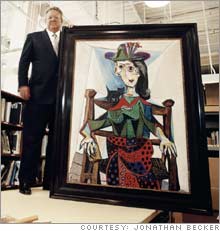|
The next step for Sotheby's CEO
Now that he's saved the auction house from disaster, Bill Ruprecht is placing some risky bets on the future.
NEW YORK (FORTUNE) - If history chooses to remember Bill Ruprecht, CEO of Sotheby's Holdings (Research), he'll go down for this: saving the 262-year-old auction house. But having surmounted the obstacles of scandal, Ruprecht must conjure a business plan that can deliver the consistent growth his investors crave. Six years ago he took on one of the worst jobs in corporate America. Before Enron, Tyco and WorldCom, Sotheby's was the modern era's most notorious case of corporate corruption. (This is an excerpt from a story that appeared in the May 15, 2005 issue of FORTUNE. To read the entire story and find out more about the scandal, click here or go to www.fortune.com.)
Ex-CEO Dede Brooks famously colluded in the back seat of a car with Christopher Davidge, the CEO of archrival Christie's. Brooks pleaded guilty to price fixing; her testimony later helped send real estate tycoon Al Taubman, Sotheby's ex-chairman, to prison. The scandal nearly destroyed Sotheby's. The fines and lawsuits it faced were huge. As the CEO chosen to right this damaged ship, Ruprecht managed a series of 11th-hour saves to keep Sotheby's afloat. Once he had just 12 hours to come up with the cash to make payroll. Today, after years of struggle, Sotheby's has resurged. In March it reported that net income for 2005 rose 80 percent on a record $513 million in revenues. Since then the company's stock price has jumped 50 percent, to a recent $30 a share. A year ago it was at $16. But ultimately, Ruprecht's marker will not just be resurrecting Sotheby's. It will be where he takes the company from here. The art world is undergoing a stunning transformation. A whole new class of superrich - from hedge fund managers to Asian tycoons to Russian oligarchs - has entered the market. And they are whipping auction rooms into feeding frenzies. Last year an unprecedented 657 individual works of art sold at auction for over $1 million each. Sotheby's and Christie's combined sold $5.9 billion worth of art - up 168 percent in two years. "The market is moving so fast," says Marc Porter, president of Christie's Americas, "there are records being set at every sale." Riding the boom, surviving the bust
The buying craze has created huge opportunities, but auctioneering remains a boom-or-bust business. Right now there is a sort of giddiness at Sotheby's. For the first time in a long time, Ruprecht is not worrying about a company in crisis. "Now I can look to the future - because I know we have one," he says. He has launched a sequence of sweeping initiatives, including stepping up Sotheby's presence in Russia and hiring expert Xiaoming Zhang away from the Guggenheim Museum to develop a business in contemporary Chinese art. He is also looking at new ways - outside the auction rooms - to bring in cash. Recently he started Sotheby's Diamonds, which sells jewels to retail customers, competing with the likes of Tiffany (Research). In addition, he is looking to rent out the Sotheby's brand name in order to add some steady fee income. Already the company receives a licensing fee from Cendant (Research) for use of the Sotheby's label on its realty business. And Sotheby's traditional business has been set on a new course. Ruprecht is rolling out an innovative marketing plan for high-end clients. In April, Sotheby's sent membership cards to 40,000 such favored customers, offering free shipping on art, discounts on private jets, special access to museums and other perks. At the same time, Ruprecht has refocused the company on high-end items - and eliminated the low end. Sotheby's no longer targets run-of-the-mill stamps and coins or everyday furnishings. It will still auction a set of china, say, but only as part of a larger estate or collection. As a result, the total number of lots sold at Sotheby's has fallen to 77,000 from 110,000 just a few years ago. It's a risky plan, to walk away from an established area of the business - especially considering that the competition has happily picked up consignments Sotheby's has dropped. So far, however, Ruprecht's bet is paying off: The company's average lot sale has grown by 50 percent, to $35,000. In the last quarter, Sotheby's net earnings rose 39 percent. Still, says Ruprecht, "in this business you can never breathe easy." Despite the rising stock price and clamoring auction rooms, there's a part of him that remains wary and distrustful. "This is a business of unanticipated events," he says. "We were in a bunker, we were being shot at every day. And now that it's passed, you can't believe you're still standing."
(This is an excerpt from a story that ran in the May 15, 2005 issue of FORTUNE. To find out more about the scandal that almost brought down Sotheby's and how it's recovering, read the complete article.) |
|

